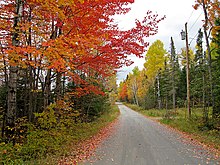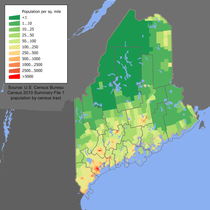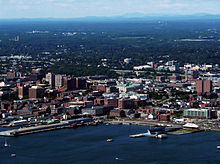Maine
Maine (English pronunciation:/me(![]() listen)) is one of the fifty states that make up the United States. Its capital is Augusta and its most populous city, Portland. It is located in the northeastern region of the country, New England division, bordering northwest, north and east with Canada (Quebec and New Brunswick Provinces), south with the Gulf of Maine (Atlantic Ocean) and southwest with New Hampshire. With 1 328 361 hectares in 2010 is the 10th least populated state, ahead of New Hampshire, Rhode Island, Montana, Delaware, South Dakota, Alaska, North Dakota, Vermont and Wyoming. He was admitted to the Union on March 15, 1820, as state number 23.
listen)) is one of the fifty states that make up the United States. Its capital is Augusta and its most populous city, Portland. It is located in the northeastern region of the country, New England division, bordering northwest, north and east with Canada (Quebec and New Brunswick Provinces), south with the Gulf of Maine (Atlantic Ocean) and southwest with New Hampshire. With 1 328 361 hectares in 2010 is the 10th least populated state, ahead of New Hampshire, Rhode Island, Montana, Delaware, South Dakota, Alaska, North Dakota, Vermont and Wyoming. He was admitted to the Union on March 15, 1820, as state number 23.
It gets its name from the French province of Maine. Part of the northern border is defined by the San Juan River, the Sainte-Croix River forms part of the eastern border, and the Salmon Falls River the southwestern boundary. Its main cities are Augusta (the capital), Portland, Lewiston, Bangor, Auburn and South Portland. Louisiana and Maine are the only states in the United States with a strong French-speaking tradition and presence.
Physical geography
The state is bordered to the southeast by the Atlantic Ocean, to the north by the Canadian provinces of Quebec and New Brunswick, and to the south by the state of New Hampshire. Maine is the largest state in the New England region, being almost half the territory of New England, in addition to being the most northerly of this region and the easternmost in the entire United States, the city of Lubec is the most eastern United States.
Maine is the most sparsely populated state on the east side of the Mississippi River. The state is called "the Pine Tree State", because 90% of the state's territory is made up of natural areas, these areas are usually completely uninhabited, some of which do not have a formal political organization on local units (unusual in New England). In Northwest Aroostook, an unorganized territory in the northern part of the state, it has, for example, an area of 6,913 km² and a population of 10, equivalent to one person for every 69 km².
Its territory occupies a total area of 91,646 km², similar in size to Portugal, which makes it the largest state in New England.
It can be divided into three distinctive physiographic regions: the coastal lowlands, the New England highlands, and the White Mountains. The coastal lowlands, which extend to the shores of the Atlantic Ocean, present an undulating landscape interrupted by numerous bays and estuaries. The abrupt capes are typical of a sinking glacial coast that has suffered the weight of vast ice caps, depressing the region. Most of the offshore islands are the tops of submerged land. One of the most spectacular rocky capes corresponds to the granite promontory of Cadillac Mountain, in Mont Desert, the state's largest island.
The New England highlands make up most of Maine; one sector is characterized by a rugged and mountainous landscape, and, on the other hand, especially around Bangor and Aroostook County, by very flat plains. Both the coastal lowlands and the New England uplands rest largely on hard metamorphic rocks.
The main elevations of Maine are in the White Mountains region, which extends into New Hampshire and Vermont. Much of the area is made up of tough granite, such as Mount Katahdin. The Longfellow Mountains constitute the most important orographic chain.
Much of Maine is covered by significant glacial deposits, such as eskers, which have left gravel ridges and coarse sands in the beds of streams that flowed under the glaciers with remarkable erosive force. Here, the soils have poor drainage and are suitable for planting pine trees and growing potatoes, but are unfavorable for other farms.
Maine has more than 5,100 streams, which empty into the Atlantic Ocean primarily through the San Juan, Saint Croix, Penobscot, Kennebec, Androscoggin, and Saco rivers. It also has more than 2,200 lakes and ponds.
As in other New England states, metallic minerals have also been of great importance in Maine, where there are limited deposits of iron ore, manganese, copper, zinc, silver, gold, platinum, and tin. Non-metallic minerals include asbestos, sand and gravel, peat, granite, limestone, quartz, mica, feldspar, graphite, and semiprecious stones.
Climate
In Maine there are three main climatic areas, which correspond to the coastal region, the northern interior and the southern interior. The coastal region extends some 32 km inland and enjoys a maritime climate; here, the average winter temperature is much milder than inland, while in summer it is cooler. The northern interior region, which occupies about 60% of the total area of the state, has a continental climate, with very low winter temperatures and times that allow the development of crops of less than 100 days. The southern interior region is the warmest in Maine. As in most of New England, tornadoes are rare in Maine, although Atlantic-forming hurricanes occasionally strike the state. Abundant coastal storms, known as northeasterly storms, bring strong winds and heavy precipitation, sometimes in the form of snow, to this part of the state.
Fauna and flora
Nearly 80% of Maine is covered in forest; about two-thirds are made up of conifers, with species such as white pine, pitch pine, Norway pine, balsam fir, hemlock, and spruce. Among the tree species of noble wood, which are used in the manufacture of furniture, are black cherry and white ash. Other abundant species include red and white oak, as well as white and yellow birch. In southeastern Washington and Hancock counties, blueberries grow in sandy soils. Lingonberries are scattered throughout the swamps. The most common wild flowers are the anemone, buttercup, daisy, mountain laurel, rhododendron, and violet.
The state's fauna abounds in white-tailed or Virginia deer and other large mammals, such as black bears and elk. Smaller mammal species include beaver, muskrat, bobcat, otter, red and gray squirrel, skunk, badger, mink, and rabbit. Birds include sparrows, reeds, and aquatic species such as ducks, grebes, seagulls, petrels, and cormorants. Trout, salmon, sea bass and pike abound in inland waters. Maine is famous for its seafood (lobster, clams, shrimp, and scallops) and its abundance of oily fish, cod, and flounder. The seals inhabit the coasts of the state.
History
When the Europeans arrived, Maine had a population of 20 Algonquian tribes, united in a loose organization known as the Abenaki or Wabunaki ('people of the dawn'). Today only the Penobscot and Passamaquoddy remain. Many of them were converted to Catholicism by French missionaries in the 17th century, and fought alongside them in the war against Englishmen.
King James I of England claimed all of New England, based on Giovanni Caboto's explorations a century earlier, and authorized the Plymouth Company to settle the area in 1606. The following year, the company founded a colony at the headwaters of the Kennebec River on the Sagadahoc Peninsula, but it only lasted a year. The French colonies on Saint Croix Island and Mont Desert Island did not prosper either.
Its economic importance was based on the trade in furs and forest products. During the American War of Independence, the British built a base near present-day Castine, in Penobscot Bay. The Penobscot Expedition (1779), in which a commando from Massachusetts tried to drive them out, was a failure.
The movement for independence from Massachusetts began in 1785. The movement was briefly suspended during the Anglo-American War of 1812 when much of Maine was invaded and occupied by British troops, however the Treaty of Ghent restored US sovereignty over Maine in 1815. After the war the movement resumed and in 1816, the Brunswick Convention popularized the independence movement. In 1819, when the Massachusetts General Court gave its assent to the Separation Act, a state constitutional convention was held in Portland. In December 1819 Maine petitioned Congress for admission to the Union, and in 1820 it was admitted under the Missouri Compromise. When Maine gained its independence, much of the territory was still unexplored; For this reason, a dispute arose over the establishment of the border that separated Maine from the Canadian province of New Brunswick. The problem was settled in 1842 by the Webster-Ashburton Treaty.
Before the American Civil War, Maine's economy was based on the marketing of lumber products. Other flourishing industries were linked to the extraction of limestone and granite, the manufacture of textiles, fishing and shipbuilding. The need for an improvement in transport motivated the arrival of the railway. After the Civil War, the relocation of the textile industry and shipyards out of New England contributed to the state's economic decline. Maine gradually recovered thanks to its pulp and paper industries, and in the early 1880s tourism became a major economic activity.
After World War II, Maine suffered a major economic crisis that affected both the countryside and the city. Issues related to energy and the environment caused great controversy in the 1970s and 1980s, when groups of citizens tried repeatedly, but without success, to shut down the activity of the only nuclear power plant in the state. Remarkable economic development took place in the 1980s, both in Maine and in most of New England.
In 1980 the federal government awarded 300,000 acres and $27.5 million to the Penobscot and Passamaquoddy after these two tribes proved in court that they owned most of Maine.
Famous American writer Stephen King was born, raised, and lives in the city of Bangor, Maine, the state where most of his novels take place.
Administration and politics
Maine is governed by a Constitution that took effect in 1820, when it joined the Union. Both the chief executive and the governor are democratically elected for a period of four years. The Governor may serve in office for more than two terms, but not consecutively. At the national level, the state appoints two senators and two representatives to the United States Congress.
Demographics
In 2007 the state of Maine had a population of 1,321,574 people, of which:
- 90% are Anglo-Saxon targets (European or European descendants).
- 5.3% are French-speaking targets (acadiens or descendants of French and Quebecers.
- 1% are Hispanic.
- 1% are black.
- 0.9% are Asian.
- 1.8% belong to other ethnic groups.
Religion
Protestants 40% - 532,900
Catholics 21% - 279,772
Other religions 7% - 93,257
No religion 32% - 426,320
Most of Maine's population is in Kennebec County, just east of Augusta. The Portland metropolitan area is the most densely populated, with nearly 40% of Maine's population. In the north of the state there are large tracts of land that are uninhabited or with very few inhabitants.
Education
The first schools in the state were founded in the early 18th century century, and in 1828 an educational system began to develop state. The most important educational centers are: the University of Maine, in Orono (1865); the University of Southern Maine (1878), in Portland; Bates College (1855), in Lewiston; Colby College (1813), in Waterville; Bowdoin College, in Brunswick; and Husson College (1898), in Bangor.
Economy
Maine's agricultural sector focuses on raising cattle (calf) and hogs, growing potatoes (potatoes), hay, corn, oats, beans (beans), peas (peas), sugar beets, and blueberries, and in dairy and egg production.
Over 95% of Maine's forests are privately owned; A considerable amount of pulp is produced each year to make paper and wood. Coniferous forests contribute 65% of annual production. Maine also has an important fishing industry, whose most valuable product is lobster; clams, scallops, shrimp, cod and herring are other species caught in significant numbers.
Maine's industry includes paper mills, footwear, leather goods, electronic equipment, processed foods, clothing, and textiles.
Tourism
Maine is home to numerous cultural institutions. One of the most notable museums in the state is the Portland Museum of Art, with a significant collection of 19th century American painting19th century.
One of its main tourist attractions is Acadia National Park, which stretches across much of Mont Desert Island. Mount Katahdin, in Baxter State Park, forms the northern terminus of the Appalachian National Trail, which stretches south to Georgia. Also noteworthy is the Roosevelt Campobello International Park.
The coast and inland lakes, rivers, and mountains of Maine provide great opportunities for swimming, rowing, hiking, fishing, and hunting. The state also has a good number of ski resorts.
Sports
Maine does not have any professional sports teams in leagues like the NFL, NBA, MLB, MLS, or NHL. Because of this, most of the state's inhabitants, as in other New England states, are fans of teams from Boston, Massachusetts, such as the Red Sox in baseball, the New England Patriots in American football, or the Boston Celtics in basketball.
In basketball, Maine has the Maine Red Claws, who play in the NBA Development League, in hockey it has the Portland Pirates of the American Hockey League, in the Eastern League baseball it has the Portland Sea Dogs, a subsidiary of the Boston Red Sox, and in soccer it has the GPS Portland Phoenix, of the USL Premier Development League.
Contenido relacionado
Guanajuato (Guanajuato)
Prague
Flag of Saint Lucia





